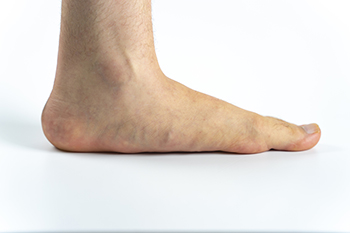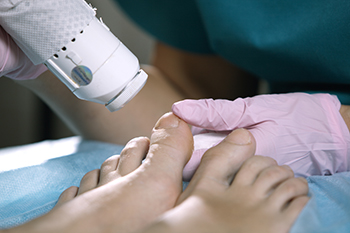Items filtered by date: December 2021
What Are Causes of Stress Fractures?
 Most people have heard of shin splints, which affect the lower leg bone as the result of hard pounding while running. But this same activity can also affect the metatarsals of the foot, resulting in stress fractures. Metatarsals are the five long bones in the foot that connect the heel and arch to the toes. The second and third metatarsals are those most likely to develop stress fractures, which are tiny cracks in the bones. This makes sense because this is the area of the foot that takes the brunt of pounding during activity. Stress fractures are thought to be more common in women and older people. Participating in certain activities – including running, playing basketball, dancing, and marching – also increases the likelihood of developing stress fractures. In addition, osteoporosis, arthritis, diabetes, and calcium deficiency can be contributing factors. It may be hard to tell if you have stress fractures, because often the pain subsides after you stop the activity. However, if you begin to feel the pain even when you are not exercising, it is suggested that you seek the care of a podiatrist, who can properly diagnose your condition and suggest an appropriate treatment plan.
Most people have heard of shin splints, which affect the lower leg bone as the result of hard pounding while running. But this same activity can also affect the metatarsals of the foot, resulting in stress fractures. Metatarsals are the five long bones in the foot that connect the heel and arch to the toes. The second and third metatarsals are those most likely to develop stress fractures, which are tiny cracks in the bones. This makes sense because this is the area of the foot that takes the brunt of pounding during activity. Stress fractures are thought to be more common in women and older people. Participating in certain activities – including running, playing basketball, dancing, and marching – also increases the likelihood of developing stress fractures. In addition, osteoporosis, arthritis, diabetes, and calcium deficiency can be contributing factors. It may be hard to tell if you have stress fractures, because often the pain subsides after you stop the activity. However, if you begin to feel the pain even when you are not exercising, it is suggested that you seek the care of a podiatrist, who can properly diagnose your condition and suggest an appropriate treatment plan.
Activities where too much pressure is put on the feet can cause stress fractures. To learn more, contact one of our podiatrists from Cascade Foot Clinic. Our doctors can provide the care you need to keep your pain free and on your feet.
Dealing with Stress Fractures of the Foot and Ankle
Stress fractures occur in the foot and ankle when muscles in these areas weaken from too much or too little use. The feet and ankles then lose support when walking or running from the impact of the ground. Since there is no protection, the bones receive the full impact of each step. Stress on the feet can cause cracks to form in the bones, thus creating stress fractures.
What Are Stress Fractures?
Stress fractures occur frequently in individuals whose daily activities cause great impact on the feet and ankles. Stress factors are most common among:
- Runners
- People affected with Osteoporosis
- Tennis or basketball players
- Gymnasts
- High impact workouts
Symptoms
Pain from the fractures occur in the area of the fractures and can be constant or intermittent. It will often cause sharp or dull pain with swelling and tenderness. Engaging in any kind of activity which involves high impact will aggravate pain.
If you have any questions please feel free to contact our offices located in Bend and Redmond, OR . We offer the newest diagnostic and treatment technologies for all your foot and ankle needs.
Gout Pain Can Be Managed
Exercises for Arthritis of the Big Toe
Arthritis, an inflammation of the joints, can cause pain and stiffness. One joint that frequently becomes affected is the big toe, which by throwing off your gait further affects other body parts. One way to help alleviate this syndrome is by doing simple exercises for the toe. Among them is the toe pull, which helps to increase mobility. Put your affected foot on a stool or chair. With one hand, hold the area where the toe meets the foot. With the other hand, gently pull the toe forward and flex it down for 10 to 20 seconds then let go. Repeat. Toe salutes are designed to stretch and build strength. Sit in a chair with your feet flat on the ground directly below the knees. Raise the big toe of one foot up, while the other toes remain flat. Hold for five seconds and relax. Then raise the four little toes up, while keeping the big toe flat. Repeat, and then change feet. If you plan to begin any exercise regime, it is best to schedule an appointment with a podiatrist who can monitor your activity and suggest other treatment options.
Arthritis can be a difficult condition to live with. If you are seeking treatment, contact one of our podiatrists from Cascade Foot Clinic. Our doctors can provide the care you need to keep you pain-free and on your feet.
Arthritic Foot Care
Arthritis is a joint disorder that involves the inflammation of different joints in your body, such as those in your feet. Arthritis is often caused by a degenerative joint disease and causes mild to severe pain in all affected areas. In addition to this, swelling and stiffness in the affected joints can also be a common symptom of arthritis.
In many cases, wearing ill-fitting shoes can worsen the effects and pain of arthritis. Wearing shoes that have a lower heel and extra room can help your feet feel more comfortable. In cases of rheumatoid arthritis, the arch in your foot may become problematic. Buying shoes with proper arch support that contour to your feet can help immensely.
Alleviating Arthritic Pain
- Exercises that stretch the foot can prevent further pain and injury and increase mobility
- Most of the pain can be alleviated with anti-inflammatory drugs, heat, and topical medications
- Massages can help temporarily alleviate pain.
It is best to see your doctor for the treatment that is right for your needs and symptoms. Conditions vary, and a podiatrist can help you determine the right method of care for your feet.
If you have any questions, please feel free to contact our offices located in Bend, OR. We offer the newest diagnostic tools and technology to treat your foot and ankle needs.
Read more about Arthritic Foot CareTips for Preventing Running Injuries
Most runners experience injuries from time to time, and pushing the body too far is probably the most common cause of foot and ankle injuries. Stress fractures and heel pain can also be caused by inefficient running habits. Increasing your cadence slowly, (the number of steps per minute) can help to prevent injury. An efficient running cadence is thought to be between 85 and 100 steps per minute, counting on one leg. Anything under 75 may increase your chances of injury. Another way to avoid injury is to reduce the amount of time your feet are on the ground while running. A third suggestion is to slightly lean into the run and let gravity help propel you forward. These changes can help to reduce the impact that causes stress on the bones and muscles. If you are experiencing foot or heel pain while or after running, please see a podiatrist as soon as possible for a diagnosis and treatment plan before continuing activity.
All runners should take extra precaution when trying to avoid injury. If you have any concerns about your feet, contact one of our podiatrists of Cascade Foot Clinic. Our doctors will treat your foot and ankle needs.
How to Prevent Running Injuries
There are a lot of mistakes a runner can make prior to a workout that can induce injury. A lot of athletes tend to overstretch before running, instead of saving those workouts for a post-run routine. Deep lunges and hand-to-toe hamstring pulls should be performed after a workout instead of during a warmup. Another common mistake is jumping into an intense routine before your body is physically prepared for it. You should try to ease your way into long-distance running instead of forcing yourself to rush into it.
More Tips for Preventing Injury
- Incorporate Strength Training into Workouts - This will help improve the body’s overall athleticism
- Improve and Maintain Your Flexibility – Stretching everyday will help improve overall performance
- “Warm Up” Before Running and “Cool Down” Afterward – A warm up of 5-10 minutes helps get rid of lactic acid in the muscles and prevents delayed muscle soreness
- Cross-Training is Crucial
- Wear Proper Running Shoes
- Have a Formal Gait Analysis – Poor biomechanics can easily cause injury
If you have any questions, please feel free to contact our offices located in Bend and Redmond, OR . We offer the newest diagnostic and treatment technologies for all your foot care needs.
The Consequences of Hammertoe
Hammertoe is a common foot deformity in which one or more of the smaller toes bends upward at the middle joint, giving the toe a hammer-like shape. This deformity is caused by an imbalance between the intrinsic and extrinsic muscles surrounding the metatarsophalangeal (MTP) joints in the toes. Hammertoes are not just unsightly, they can also be painful. The tops of the toes may rub against your shoes while you walk, causing the toes to become callused. The irregular shape of the toes can make it difficult to find comfortable, well-fitting shoes. In some cases, the hammertoes can also alter your gait as you consciously or unconsciously make changes to the way you walk in order to avoid toe pain or keep your shoes on your feet. Hammertoes worsen over time if they are left untreated. If you have hammertoes, please seek the care of a podiatrist.
Hammertoe
Hammertoes can be a painful condition to live with. For more information, contact one of our podiatrists from Cascade Foot Clinic. Our doctors will answer any of your foot- and ankle-related questions.
Hammertoe is a foot deformity that affects the joints of the second, third, fourth, or fifth toes of your feet. It is a painful foot condition in which these toes curl and arch up, which can often lead to pain when wearing footwear.
Symptoms
- Pain in the affected toes
- Development of corns or calluses due to friction
- Inflammation
- Redness
- Contracture of the toes
Causes
Genetics – People who are genetically predisposed to hammertoe are often more susceptible
Arthritis – Because arthritis affects the joints in your toes, further deformities stemming from arthritis can occur
Trauma – Direct trauma to the toes could potentially lead to hammertoe
Ill-fitting shoes – Undue pressure on the front of the toes from ill-fitting shoes can potentially lead to the development of hammertoe
Treatment
Orthotics – Custom made inserts can be used to help relieve pressure placed on the toes and therefore relieve some of the pain associated with it
Medications – Oral medications such as anti-inflammatories or NSAIDs could be used to treat the pain and inflammation hammertoes causes. Injections of corticosteroids are also sometimes used
Surgery – In more severe cases where the hammertoes have become more rigid, foot surgery is a potential option
If you have any questions please contact our offices located in Bend and Redmond, OR . We offer the newest diagnostic and treatment technologies for all your foot and ankle needs.
Do I Need to See a Podiatrist for Flat Feet?
 When the feet are pressed flat while standing, this can often be a result of the condition known as flat feet or fallen arches. Usually, flat feet are not serious and do not need treatment. They should not interfere with your daily physical activities either. However, in more serious cases, patients with flat feet should consult with a podiatrist. Common reasons a podiatrist should be consulted include flat feet that are painful, stiff, or weak. Patients who have flat feet and often injure their feet or ankles, have a balance problem, or have only one foot that is affected, should consult with a podiatrist as well. For certain cases of flat feet, surgery may be necessary, but in most cases, a podiatrist will be able to suggest proper footwear and exercises in order to treat this condition.
When the feet are pressed flat while standing, this can often be a result of the condition known as flat feet or fallen arches. Usually, flat feet are not serious and do not need treatment. They should not interfere with your daily physical activities either. However, in more serious cases, patients with flat feet should consult with a podiatrist. Common reasons a podiatrist should be consulted include flat feet that are painful, stiff, or weak. Patients who have flat feet and often injure their feet or ankles, have a balance problem, or have only one foot that is affected, should consult with a podiatrist as well. For certain cases of flat feet, surgery may be necessary, but in most cases, a podiatrist will be able to suggest proper footwear and exercises in order to treat this condition.
Flatfoot is a condition many people suffer from. If you have flat feet, contact one of our podiatrists from Cascade Foot Clinic. Our doctors will treat your foot and ankle needs.
What Are Flat Feet?
Flatfoot is a condition in which the arch of the foot is depressed and the sole of the foot is almost completely in contact with the ground. About 20-30% of the population generally has flat feet because their arches never formed during growth.
Conditions & Problems:
Having flat feet makes it difficult to run or walk because of the stress placed on the ankles.
Alignment – The general alignment of your legs can be disrupted, because the ankles move inward which can cause major discomfort.
Knees – If you have complications with your knees, flat feet can be a contributor to arthritis in that area.
Symptoms
- Pain around the heel or arch area
- Trouble standing on the tip toe
- Swelling around the inside of the ankle
- Flat look to one or both feet
- Having your shoes feel uneven when worn
Treatment
If you are experiencing pain and stress on the foot you may weaken the posterior tibial tendon, which runs around the inside of the ankle.
If you have any questions please feel free to contact our offices located in Bend and Redmond, OR . We offer the newest diagnostic and treatment technologies for all your foot and ankle needs.




